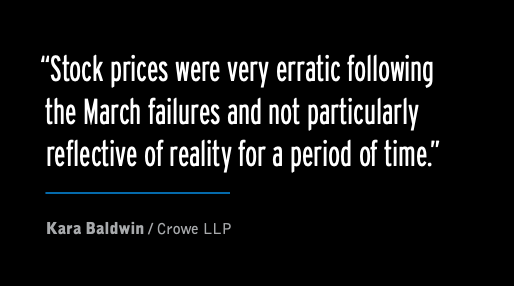
2023 RankingBanking: The Best Banks Played Defense
Brought to you by Crowe LLP

That began to change in late 2022. The Federal Reserve, in its fight against inflation, ushered in a steep increase in interest rates. Deposits started to slowly move out of banks. But worse, bank assets, including bonds and loans, went underwater as rates rose.
We’ve seen a similar story before, following Fed Chair Paul Volcker’s rate hikes back in the 1970s and 80s. Unfortunately, some banks forgot the basics of asset/liability management.
“It’s easy to manage interest rate risk,” says Dory Wiley, CEO of Commerce Street Holdings, which offers investment banking services; Wiley also invests in bank stocks. He believes banks should have been more selective about accepting such high deposit volumes; hedging could have also helped them manage duration risk. If banks tell him they got hung to dry in the securities portfolio but they have plenty of capital, “that’s a red flag to me, because asset/liability management’s not a new thing,” he says.
Each year, Bank Director’s RankingBanking study examines the performance of the 300 largest publicly traded banks. Over time, it has recognized numerous banks that consistently perform well — companies that you’ll find featured within the 2023 RankingBanking report, sponsored by Crowe LLP.
But some that performed well in past iterations of the annual scorecard didn’t survive far into 2023; others are struggling. Those banks “have forgotten some of the basics, blocking and tackling,” says Crowe Partner Rick Childs. “That is not to block yourself into incredibly long durations on your portfolios.”
Bank Director leveraged a consistent set of metrics to determine the best banks, based on calendar year 2022 results: return on average equity and return on average assets, the tangible common equity ratio, nonperforming assets and total shareholder return. Those metrics measure profitability, capital adequacy, asset quality and investor returns. S&P Global Market Intelligence provided the data, which was analyzed by Piper Sandler & Co. Each of the five metrics were ranked; the scores were then summed up to determine a final score. The lower the score, the better the rank.
The ranking identifies the top 25 U.S. banks, and ranks all 300 by asset size:
Several of the industry’s more conservative stalwarts top this year’s ranking.
West Virginia’s City Holding Co., with $5.9 billion in assets at the end of 2022, ranked third of all banks in this year’s study and has rated highly for several years running. In her profile of the bank, City Holding Co. Finds Strength in Community, Director of Research Laura Alix ties the bank’s success to its focus on retail customers, persevering in spite of slow growth markets.
Further south, ServisFirst Bancfshares, based in Birmingham, Alabama, has thrived by operating a branch-light model serving commercial customers in the booming Southeast. With $14.6 billion in assets at the end of 2022, ServisFirst ranked No. 17 of all the banks in the study. Over the past several years, it’s outperformed many of its peers in the $5 billion to $50 billion asset class. Bank Director Editor-in-Chief Naomi Snyder shares how the bank’s success derives from efficiency and a strong sales culture in her profile, ServisFirst’s “Humble and Hungry” Approach to Success.
Some banks outshined others due to their inherent flexibility and strength.
Los Angeles-based Preferred Bank and Wilmington, Delaware-based The Bancorp leveraged strong balance sheet management practices to weather the changing interest rate environment. They came in at No. 10 and No. 16 overall this year, respectively. Preferred Bank tightened up on underwriting, as Chairman and CEO Li Yu explains to Kiah Lau Haslett, Bank Director’s banking & fintech editor. “If you lose a loan, that’s fine because we choose not to compete,” he tells her. You’ll find out more about how those banks are responding to a higher rate environment in her story, How the Best Banks Manage the Balance Sheet.
Recent turmoil in the industry wreaked havoc on bank stocks. This year’s RankingBanking study finds total shareholder return muted in 2022, with a median -5.9% for all banks in the ranking and 6.5% for the 25 best banks. Bank stocks suffered even more in 2023, plummeting after the bank failures in March. The KBW Nasdaq Regional Banking Index was down 9% year-to-date through July 26.
“Stock price movement was a bit more reflective and aligned with individual performance in 2022,” says Kara Baldwin, a partner at Crowe. “Stock prices were very erratic following the March failures and not particularly reflective of reality for a period of time.” She adds that pricing remains low compared to the rest of the market.
Investors are viewing banks differently, with short selling activity impacting the market — an environment explored in How Investors View the Best Banks, penned by Emily McCormick, vice president of editorial & research at Bank Director. Today, long-term bank investors prize capital, among other traits that can help a bank survive an economic downturn. Regional bank stocks have suffered, such as East West Bancorp’s, the top bank above $50 billion in assets. But the Pasadena, California-based bank’s leaders believe a long-term view on capital management could turn investor sentiment around.
Four banks that appear in this year’s ranking met their end in spring 2023 due to depositor panic. “In the 30 years that I’ve been covering banks, I’ve never seen liquidity get constrained that quickly,” says Mark Fitzgibbon, managing director and head of financial services research at Piper Sandler. “There was a perception during 2022 that the companies that had asset sensitive balance sheets … would fare much better in a higher interest rate environment.” That didn’t prove to be the case due to long-duration, low interest assets. The Federal Reserve paused its rate hikes in June 2023, after raising them by an unprecedented 500 basis points since March 2022. The Fed resumed its rate increases in July 2023, ticking up rates another 25 basis points.
Three of those collapsed banks reported poor performance last year. SVB Financial Group, which failed in March, and First Republic Bank, which failed in May, ranked toward the bottom among peers above $50 billion in assets. The previous year, SVB came in at No. 19 among the large banks, and First Republic tied for No. 26. Silvergate Capital Corp. was the first domino to fall, filing for bankruptcy in March 2023. It ranked last among all banks in the ranking for its 2022 performance; for 2021, the crypto-focused bank ranked No. 82 among peers with between $5 billion and $50 billion in assets.
Another bank serving the crypto sector, Signature Bank, actually performed better against many of its peers in 2022, tying for tenth with Capital One Financial Corp. and scoring well across all metrics. Signature ranked similarly well for its performance in 2021. Unfortunately, the bank’s strong performance didn’t prevent a run on the bank’s deposits in March 2023. SVB, Silvergate, First Republic and Signature operated fairly concentrated business models, notes Childs. The best banks — those posed to weather a potential storm ahead — do the opposite.
“When you look at institutions that do well, they have fairly diversified business models,” Childs says. “They execute well, they have better than average rates on their asset side of the portfolio, and they’ve got good funding sources that are stable and at a relatively low cost.”
Click here to access the complete RankingBanking study.
Emily McCormick is the vice president of editorial and research for Bank Director.
Naomi Snyder is the editor-in-chief for Bank Director.
Laura Alix is the director of research for Bank Director.
Kiah Haslett is the banking and fintech editor for Bank Director.



